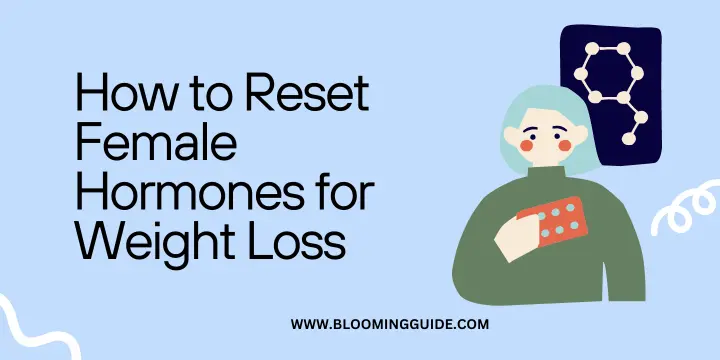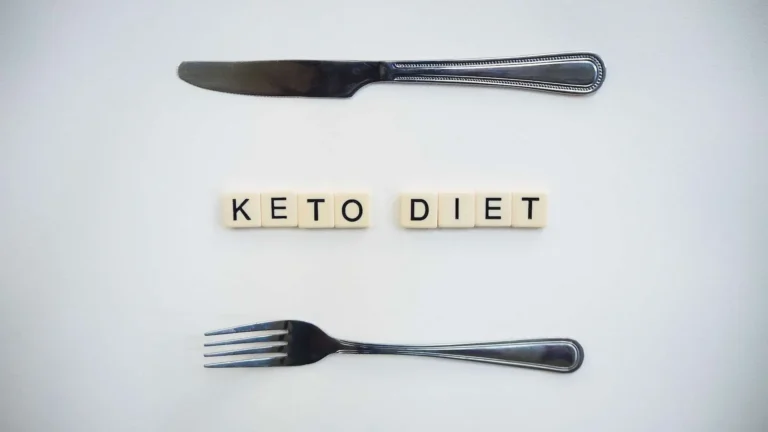Easy Keto Bread Recipe: How To Make Good Keto Bread!
In the ever-evolving landscape of dietary choices, the ketogenic diet has emerged as a game-changer, offering a low-carb, high-fat lifestyle that many find beneficial. At the heart of the ketogenic dietary approach lies a fascinating creation: Keto Bread.
Unlike traditional bread, this low-carb alternative embodies a concoction of carefully chosen ingredients, specifically crafted to align with the principles of the keto diet while providing the comfort and satisfaction of indulging in a loaf of bread.
Keto Bread isn’t just a recipe; it’s a cornerstone in low-carb baking, offering a delightful solution for those craving the familiarity of bread while adhering to a low-carbohydrate lifestyle.
Its creation involves combining science and culinary finesse, replacing high-carb flour with innovative alternatives kike coconut flour and almond flour. The result is a satisfying and guilt-free slice of keto friendly bread.
If you want to learn how to make the best Keto Bread, then embark with us on this delightful journey through the world of Keto Bread, as we explore its essence, delve into the crafting process, and unlock the secrets to baking your low-carb loaves that are both delicious and nutritious.
Whether you’re a seasoned keto enthusiast or simply curious about exploring low-carb alternatives, the realm of Keto Bread beckons, promising delightful creations straight from your oven to your table and this low carb bread recipe and its variations will unlock the perfect keto recipe for bread for you!
I. Understanding The Keto Bread: Unveiling Low-Carb Baking Brilliance
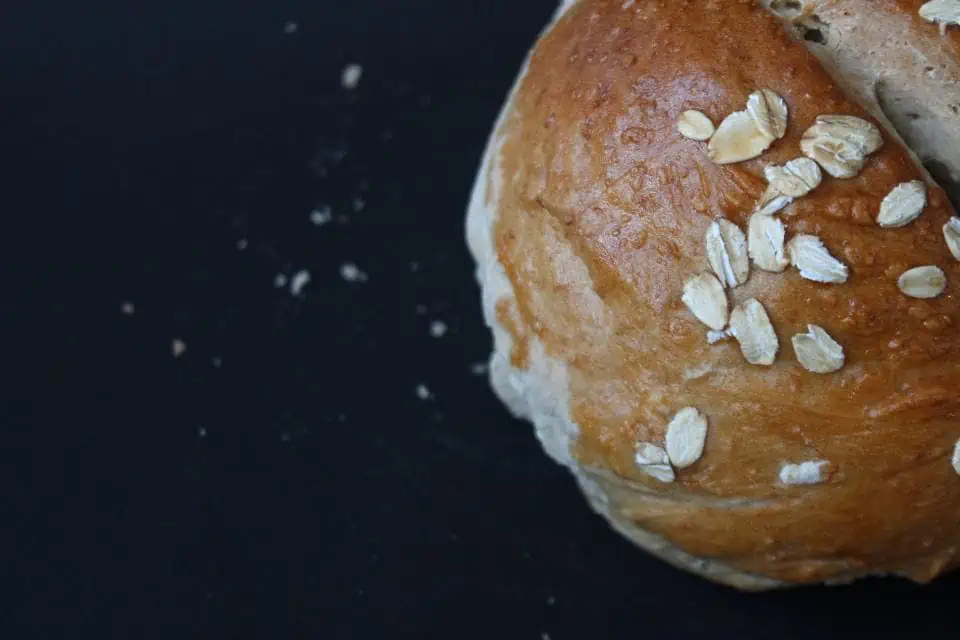
Keto Bread, unlike other bread choices, is a nutritious alternative for those who simply can’t give up on eating bread.
It’s important to understand why individuals who adopt the ketogenic diet, replace traditional and commonly consumed food choices like bread and transform it into a keto-friendly alternative.
While the fundamental aspect of the edible remains the same, the nutritional values of the food witness a transformative refresh.
It’s all about a balanced macronutrient ratio with the keto diet, where the emphasis is on consuming lower carbs.
Similar is the case with keto bread.
You can make this bread with keto-friendly ingredients and make use of the best keto bread recipe that we’re going to cover in a bit.
A. Importance of Keto Bread in Low-carb Lifestyle
Keto Bread is a crucial element in the repertoire of a low-carb lifestyle.
As individuals transition to a ketogenic or low-carb diet, one of the primary challenges often faced is bidding adieu to traditional bread.
An easy Keto Bread recipe is a savior, offering a viable solution that allows adherents to relish the comfort of bread without straying from their low-carb regimen.
Its significance lies not just in its resemblance to traditional bread but also in its adherence to the macronutrient ratios essential for ketosis.
B. The Role of Keto in Low Carb Bread
Keto Bread is an ingenious creation that swaps out high-carb ingredients typically found in regular bread recipes for low-carb alternatives.
This bread variant is meticulously crafted, focusing on substituting traditional flour with ingredients like almond flour, coconut flour, or flaxseed meal, ensuring a significantly reduced carbohydrate content while maintaining a delicious taste and texture.
It serves as a vehicle for keeping net carb intake low, thereby aiding in sustaining ketosis, the metabolic state where the body efficiently burns fat for fuel.
C. Different Types of Keto Bread Variations
Keto Bread boasts diverse variations, each offering unique flavors, textures, and suitability for various dietary preferences.
From almond flour-based loaves to coconut flour variations and even innovative recipes featuring seeds and psyllium husk, the options are vast.
Some recipes may be tailored to suit nut-free, dairy-free, or egg-free dietary requirements, allowing for inclusivity and catering to a wider audience within the keto community.
II. Keto Friendly Bread Recipe: Essential Ingredients To Make Good Keto Bread
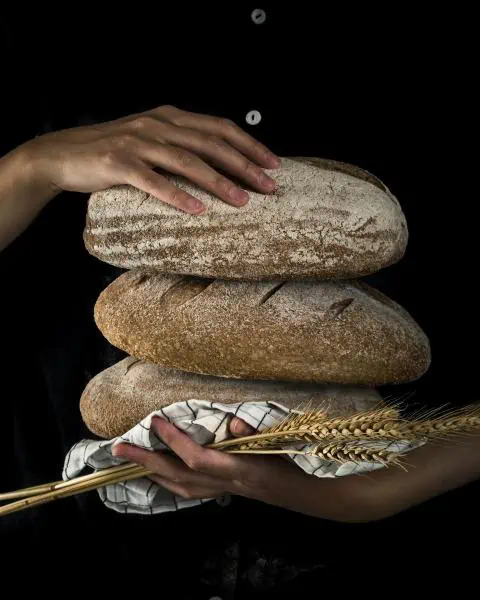
When we talk about keto bread, it’s all about the ingredients.
Before diving into the recipe itself, it’s important to learn about the ingredients and how they play a role in transforming a regular loaf of bread into a low-carb nutritional powerhouse.
A. Keto Bread: Overview of Core Ingredients Needed To Follow Keto Diet
Creating delectable Keto Bread involves a selection of essential ingredients that deviate from the conventional components of traditional bread recipes.
These ingredients typically include almond flour, coconut flour, psyllium husk powder, eggs or egg replacers, healthy fats like butter or coconut oil, baking powder or baking soda, and occasionally, ingredients like apple cider vinegar.
Each ingredient plays a unique role in the recipe, contributing to the texture, rise, and flavor of the final product.’
Here’s an overview of the core ingredients to consider before making keto bread:
- Almond Flour: This low-carb, high-fat flour alternative is a staple in many Keto Bread recipes. It offers a nutty taste, and a fine crumb texture, and is rich in healthy fats and protein.
- Coconut Flour: Another favored option, coconut flour, is highly absorbent and provides a denser texture. It contributes to the bread’s moisture content and enhances flavor with a hint of coconut.
- Psyllium Husk Powder: Acting as a binding agent, psyllium husk powder aids in moisture retention and helps mimic the gluten structure found in traditional bread, resulting in a better crumb texture.
- Eggs or Egg Replacers: Eggs are often used in Keto Bread recipes for structure and moisture. For those with dietary restrictions, egg replacers like flax eggs or aquafaba serve as viable alternatives.
- Healthy Fats: Ingredients like butter, ghee, coconut oil, or olive oil provide the bread with moisture and a rich taste while aligning with the high-fat, low-carb ketogenic approach.
- Leavening Agents: Baking powder or baking soda helps the bread rise, ensuring a lighter texture despite the absence of gluten.
- Apple Cider Vinegar: Sometimes used in recipes, apple cider vinegar contributes to the bread’s texture and acts as a leavening agent while neutralizing flavors.
III. Best Keto Bread Recipe: Basic Steps to Making Keto Bread
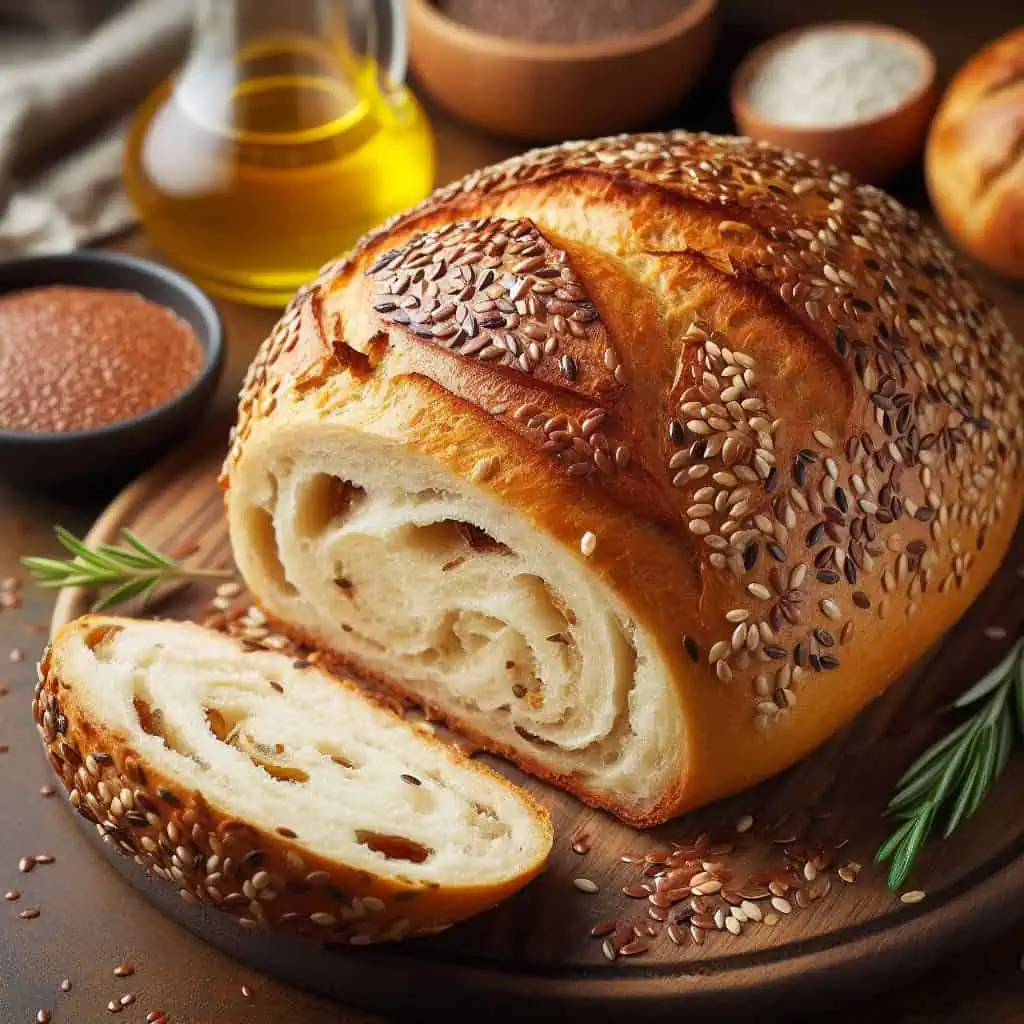
While you may think that making keto bread may be complicated; however, the process itself is complete in a matter of few simple steps.
I assure you that if you follow this easy recipe, you’ll want to try it out every other day.
Not only will this keto bread taste good, but you won’t even feel that you’ve replaced traditional or real bread with an alternative that has rich nutritional value.
I’ve personally tried this recipe when I was observing the ketogenic diet, and have found it to be quite simple and delicious.
Without further ado, let’s head on to the step-by-step process of preparing the keto bread.
A. Step-by-Step Process for an Easy Keto Bread Recipe
Making keto bread isn’t that complicated if you follow certain instructions and ensure that you have the right guidance regarding the steps required to make keto-friendly bread.
Once you understand the steps and successfully make your first keto bread, you’ll want to prepare a second keto bread right away. Bread on the keto diet doesn’t get any better than this.
Every keto fanatic needs to start taking note of the steps as bread made like this is a match made in heaven.
Here are the steps to observe while making the perfect keto bread.
i. Preparation: Gathering The Desired Ingredients
First, you need to gather all the ingredients and kitchen tools required for the recipe.
For a basic Keto Bread, you’ll need almond flour, coconut flour, psyllium husk powder, baking powder, eggs (or egg replacers for a vegan option), butter or coconut oil, apple cider vinegar (if using), and a pinch of salt.
Ensure that the almond flour and coconut flour are finely ground and fresh, as using almond flour and coconut flour that is finely grounded and fresh ensures the best texture and quality of bread.
Please note that you can customize the choice of ingredients according to your dietary restrictions or precautions. You can go with gluten free or sugar free choices of ingredients and their variations.
iI. Mixing Dry Ingredients: The Combining Phase
Once you’ve gathered all the ingredients for preparing this great recipe, you need to start combining the dry ingredients.
Make this recipe happen by taking a large mixing bowl.
In the bowl, add the almond flour by around 1 1/2 cups, the coconut flour by 1/4 cup, psyllium husk powder by 1/4 cup, baking powder by 1 tablespoon, and a pinch of salt.
Whisk the dry ingredients thoroughly to break up any clumps and achieve an even distribution of ingredients. The combination of almond flour and coconut flour provides a balance of texture and flavor in Keto Bread.
iII. Mixing Wet Ingredients: The Combining Phase Continued
After mixing all the dry ingredients, you need to advance with the recipe by preparing the wet ingredients. Don’t worry, it’s easy to make.
In a separate bowl, crack and whisk 4 large eggs.
If preferred, flax eggs or chia seed eggs can be used as an egg replacement for a vegan option.
Add 1/4 cup of melted butter or coconut oil to the eggs.
Optionally, include 1 tablespoon of apple cider vinegar, enhancing the bread’s rise and structure.
iv. Combining Ingredients: Making The Magic Happen
As we proceed towards making the best keto bread, here comes the step where you need to combine all the ingredients.
Start by gradually pouring the wet ingredients into the bowl containing the dry mixture, stirring continuously as you combine them.
Use a spatula or wooden spoon to blend the ingredients thoroughly until a cohesive dough forms.
The dough might appear slightly wet and sticky initially, but it will gradually thicken as the coconut flour absorbs the moisture.
v. Resting the Dough: Let The Bread Cool
Once you’ve successfully combined all the ingredients and followed the recipe so far, you’re now one step closer to a delicious bread recipe that’s keto-friendly.
Now, you need to allow the dough to rest for approximately 5-10 minutes.
This resting period allows the psyllium husk and coconut flour to absorb the liquid, resulting in a firmer and more manageable dough.
Remember that each step is crucial on its own, but this one is especially important because the bread does not rise properly in the oven if it’s not adequately cooled or rested.
During this time, preheat the oven to the recommended temperature for baking Keto Bread, usually around 350°F (175°C).
vI. Shaping the Dough: Almost There
Are you enjoying the step-by-step process of preparing the best keto bread so far?
Don’t worry, you’re almost there.
This easy to follow recipe has a few more steps and then you’re going to be enjoying delicious and nutritious keto-friendly bread in no time.
After you’ve rested the dough for a while, you now need to transfer the dough onto a parchment-lined baking pan or a loaf pan with parchment paper on it.
Shape it into a loaf by gently molding the dough into the desired bread shape.
You can use your hands or a spatula to shape it.
Ensure the dough is evenly distributed in the pan for uniform baking.
vII. Baking: Let The Oven Take Over
If you were wondering when you’d get to bake the bread, then the wait is over.
Once you’ve managed to shape the dough and transfer it into a baking pan, all the work in this recipe will now come to life once your prepared keto bread dough goes into the oven for baking.
Start by placing the prepared bread pan in the preheated oven.
Bake the Keto Bread in the oven for approximately 45-55 minutes, depending on your oven’s temperature accuracy.
Keep an eye on the bread’s progress and adjust the baking time if needed.
The bread is ready when it turns golden brown on top, and a toothpick inserted into the center comes out clean.
vIII. Cooling: The Final Touch
Every keto bread recipe on the internet that you’ve come across will have one thing in common, it’s that you need to follow the steps and instructions carefully.
If you’ve managed to follow the recipe exactly the way it should’ve been followed, then all the effort you’ve put in so far and the ingredients you’ve used in this recipe will come to life.
The last and final step involves simply letting your oven-baked bread cool down.
Once fully baked, remove the bread from the oven and let it cool in the pan for about 10-15 minutes.
Then, carefully transfer the bread from the pan to a wire rack to cool completely.
Cooling the bread entirely before slicing ensures it holds its shape and allows for easier slicing without crumbling.
After that, you can dive in and if the satisfying chew of wheat bread is something you fancy, then this keto bread will dominate your taste buds.
B. Tips for Successful Keto Bread Baking
Following a keto diet isn’t for the faint-hearted.
It requires commitment and dedication to a balanced macronutrient ratio and simply understanding how nutritional values work in the ketogenic diet.
There are many keto bread recipes to try and don’t be surprised if you see the recipe card of keto bread now and then.
However, every recipe will involve baking and that’s the part where the magic happens.
Take note of the following tips if you want to bake the perfect keto-friendly bread today, tomorrow, or later in your keto journey:
- Precision in Measurements: Accurate measuring of ingredients is crucial for Keto Bread. Use measuring cups or a kitchen scale for precise quantities.
- Quality Ingredients: Opt for high-quality ingredients like psyllium husk, almond flour or coconut flour, and fresh leavening agents for the best results.
- Mixing Technique: Ensure thorough mixing to achieve a consistent texture. Overmixing can affect the final product’s quality.
- Proper Placement: You need to make sure that you loaf pan your bread mixture properly. Proper pan placement before putting the batter in the oven is crucial for the proper and balanced texture of the bread.
- Proper Oven Temperature: Preheat the oven accurately to the recommended temperature to facilitate proper rising and baking. It’s also important to note that you need to rest the mixture for a bit.
- Cooling Period: Allow the bread to cool entirely before slicing to prevent it from crumbling and maintain its structure.
IV. Creative Keto Recipe Variations
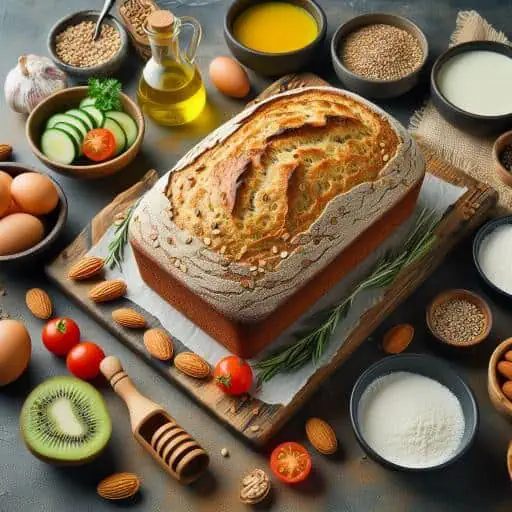
Keto-friendly bread is an amazing dietary choice. The bread flavor is good and it packs excellent nutritional value.
However, if you’re looking to take it up a notch, then try out our suggested recipe variations to make the most customized and ideal keto bread for you.
A. Different Types of Keto Bread Recipes
- Almond Flour Keto Bread: Bread made with Almond flour serves as a staple in many Keto Bread recipes, offering a nutty flavor and moist texture. It’s often combined with eggs, baking powder, and occasionally psyllium husk for structure. If you don’t like adding coconut flour to the mixture, then you can simply go with the bread with almond flour only.
- Coconut Flour Keto Bread: Use this bread recipe variation if you want an exclusive coconut flour-based keto bread. Ingredients like Coconut flour in bread can offer a great deal of health benefits. Coconut flour is known for its absorbent nature and is a great choice if you’re a fan of the ingredient. It also requires less quantity compared to almond flour due to its high absorption capacity and offers a slightly denser texture.
- Flaxseed Keto Bread: Flaxseeds, when ground into a flour-like consistency, create a soft and nutty bread. The omega-3 fatty acids in flaxseeds contribute to its nutritional profile. You can try out this flour bread recipe to add variety to your keto-friendly choice of bread. It also makes for a dairy free alternative, if you don’t like dairy products.
B. Variations like Keto Garlic Bread, Keto Bagels, etc.
- Keto Garlic Bread: Enhance your Keto Bread recipe by adding garlic powder or minced garlic to the dough. Brush the top with a mixture of melted butter, garlic, and herbs for a savory, aromatic Keto Garlic Bread.
- Keto Bagels: Shape the Keto Bread dough into bagel rounds before baking. You can top them with sesame seeds, poppy seeds, or a sprinkle of everything bagel seasoning for a flavorful twist.
- Keto Cheese Bread: Mix shredded cheese, such as cheddar or mozzarella, into the dough for a cheesy Keto Bread. Sprinkle additional cheese on top before baking for an extra cheesy crust.
- Keto Cinnamon Bread: Sweeten your Keto Bread by incorporating cinnamon into the dough and adding a sugar-free sweetener. It’s perfect for a delightful breakfast or a guilt-free snack.
- Keto Seed Bread: Introduce a variety of seeds like sunflower seeds, pumpkin seeds, chia seeds, or sesame seeds to the Keto Bread mixture. These add texture, crunch, and a nutritional boost to your bread.
- Keto Nut Bread: Incorporate chopped nuts like pecans, walnuts, or almonds into the dough for a nutty flavor and added protein. It’s a delightful option for those looking for heartier bread.
- Keto Mug Bread: Prepare a single-serving Keto Bread in a mug using a combination of coconut flour or almond flour, eggs, baking powder, and flavorings. Microwave for a quick and easy bread fix.
Each variation offers a unique flavor profile, allowing individuals on a Keto diet to enjoy a diverse range of bread alternatives while staying within their low-carb parameters.
V. Tips for Perfecting Keto Bread

Now that you’ve finally made your first keto bread, you need to keep a few important tips in mind if you want your keto-friendly bread to turn out perfect.
Whether you’re following this keto bread recipe for sandwiches for lunch or simply to grab a toast for breakfast, the ideal keto bread recipe involves incorporating a few important tips.
Let’s walk through some important tips for the best keto bread.
A. Troubleshooting Common Keto Bread Baking Issues
- Dry Texture: If the bread turns out dry, try adding more moisture-rich ingredients like additional eggs, yogurt, or a touch of oil. Adjusting the baking time or temperature might also help prevent over-drying.
- Dense Texture: A heavy or dense texture can result from using too much almond flour or coconut flour without enough binding agents like eggs or psyllium husk. Ensuring proper ratios of wet and dry ingredients can help achieve a lighter texture.
- Crumbly Bread: Adding xanthan gum or extra eggs might improve the bread’s structure and reduce its tendency to crumble. Allow the bread to cool completely before slicing to avoid crumbling.
- Sinking in the Middle: This issue may stem from inadequate leavening agents like baking powder. Ensure the baking powder is fresh and use the right quantity according to the recipe.
B. Additional Advice for Better Keto Bread Results
- Ingredient Quality: Use high-quality ingredients for the best taste and texture. Freshly ground almond flour and coconut flour, along with organic or pasture-raised eggs, often yield better results.
- Proper Mixing: Thoroughly combine the wet and dry ingredients but avoid overmixing the dough, which can result in a dense texture.
- Baking Tools: Invest in quality baking tools such as parchment paper, non-stick loaf pans, or silicone molds to prevent sticking and ensure easy removal of the bread.
- Experiment and Adapt: Adjust recipes according to personal taste preferences. Explore different flavor variations and ingredient combinations to find the best Keto Bread for your palate.
- Storage Tips: Store Keto Bread in an airtight container or wrap it tightly in foil or plastic wrap to maintain freshness. Refrigerating or freezing slices can extend their shelf life.
By understanding potential issues and implementing these suggestions, you can refine your Keto Bread baking skills and achieve consistent and satisfying results.
VI. Final Thoughts: Summing It Up!
A. Recap of the Benefits of Keto Bread
Keto Bread stands as a versatile and satisfying alternative for those embracing a low-carb or ketogenic lifestyle.
Laden with healthy fats, moderate proteins, and minimal carbohydrates, this bread offers a delicious way to indulge in baked goods without jeopardizing ketosis.
Moreover, it’s often gluten-free, making it suitable for individuals with gluten sensitivities or those following a gluten-free diet.
With its adaptability and plethora of variations, Keto Bread opens a world of culinary exploration.
Almond flour, coconut flour, seeds, and various flavors and seasonings add depth and diversity to the bread, enabling you to relish everything from traditional loaves to savory bagels or aromatic garlic bread.
B. Encouragement to Experiment and Enjoy Homemade Keto Bread
Embark on a culinary journey, experimenting with different recipes, ingredients, and baking techniques.
Dive into the realm of Keto Bread to discover textures, flavors, and creations that perfectly complement your low-carb lifestyle.
Whether it’s a soft loaf for morning toast or savory rolls to accompany meals, homemade Keto Bread offers a delicious gateway to wholesome baking.
Take joy in the process, relish the aromas wafting from the oven, and savor each bite of your custom-crafted Keto Bread.
Allow this baking venture to not only enrich your diet but also enhance your journey toward healthier living.
Some Additional FAQs
Here are some additional FAQs regarding Keto Bread that you may want to know about.
A: Yes, you can! Freezing Keto Bread is a fantastic way to extend its shelf life. Slice the bread, wrap individual portions in parchment paper, and store them in an airtight container or freezer bag. When needed, thaw slices in the toaster or at room temperature for a quick, ready-to-eat treat.
A: If you’re allergic to nuts or looking for alternatives, coconut flour, sunflower seed flour, or flaxseed meal can serve as substitutes for almond flour. Each alternative may require adjustments to the recipe due to varying absorption rates.
A: Yes, you can explore egg-free options using ingredients like flaxseed meal, psyllium husk, or chia seeds as binding agents. Experiment with these alternatives to achieve a satisfying texture and structure in your Keto Bread.
A: To maintain moisture in your Keto Bread, consider adding ingredients like Greek yogurt, cream cheese, or sour cream to the recipe. These additions not only contribute to moisture but also enhance the bread’s richness.
A: While traditional yeast may not be used in Keto Bread, baking powder or baking soda is often used as leavening agents. Achieving a rise in Keto Bread primarily depends on the right combination of leavening agents, ensuring a satisfactory texture.
A: Absolutely! Keto Bread toasts wonderfully, providing a crispy exterior while maintaining a soft, flavorful interior. Adjust your toaster settings or use a pan to achieve the desired level of crispiness.
A: Typically, homemade Keto Bread lasts for about 3-5 days when stored properly in an airtight container at room temperature. Freezing slices or loaves can extend their shelf life for up to a month or more.


